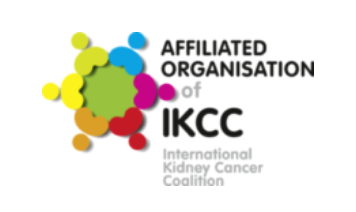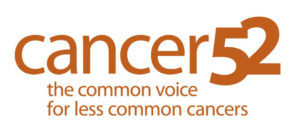“Kidney cancer broke my leg”. That’s what I say to anyone who asks me “what happened to you” as I walk around on crutches, and I get some strange looks. I was diagnosed with a kidney tumour in 2011 and had a nephrectomy in August that year. The urologist was very confident they had got it all, and I was monitored with alternate 6 monthly CT or ultrasound scans, all of which showed nothing. I had no idea I had secondary cancer until I started to develop a limp in August 2014.
I would trip over something, and it would hurt, but I thought it was just a muscle thing and I soldiered on, as I was full on renovating our investment flat for our son to move into. Then the limp became worse, and I had to use a stick.
Right, I thought, time to get this checked out. I went to the doctors on the Friday who manipulated it and arranged for an x-ray the next day. I never made it – that Saturday morning in September 2014 my femur broke as I was sliding across the bed to get out. It was an experience I wouldn’t wish on anyone. After 36 hours in traction, I had an operation to fix the leg with a long rod through the femur, with bone screws top and bottom. Apparently the met was large – my best estimate from the x-rays is it had eaten a 6cm hole in the bone.
Once back on the ward, as well as coping with the leg, we had the consultants visit and the gist of the conversation was ‘that’s it now, you’ve got secondary kidney cancer and there is no cure”. I guess they were thinking it must be widespread if it’s that big in the bone. They were dark times indeed. My wife and I were devastated. There was not one reassuring word and the whole implication was I haven’t got long. Medical staff were astounded when both CT and bone scans showed that the only met was the one in my femur, so perhaps not on my last legs yet (sorry about the pun!).
I was given 5 doses of radiotherapy. I never really understood why but they said it was for the pain, but once pinned I didn’t have any bone pain.
I was discharged after 2 weeks, with a whole new landscape in my life – I was told I could only put partial load on the leg, so I had to use crutches. I had limited flexibility and little stability in the leg, so I had to sleep downstairs in the front room (or try to – my mind was in turmoil and at a low ebb). I couldn’t use the stairs, so had to flannel wash in the utility, luckily, we have a downstairs loo and sink. My wife was amazing during this time, doing lots.
After the radiotherapy, I saw the oncologist, who gave a little more cause for optimism in that she was seeing patients who had been on sunitinib for 3 and half years. And I was young (57 at the time).
So I started on sunitinib and after 3-4 months of not going into decline, I made a mental adjustment and got on with things as best I could with crutches. I am lucky that I retired early so I don’t have the stresses of work to deal with.
The first couple of cycles on a regime of 4 weeks on tablets and 2 weeks off were tough (I was started on the highest dose 60mg). I had very sore mouth ulcers, difficulty swallowing, diarrhoea, also dry mucus leading to bunged up nose, leading to lost sleep, got an abscess, a lot of fatigue (although not debilitating). After four cycles it was agreed to drop to 40mg and switch to a 2 weeks on and 1 week off regime, which I did and I instantly found this much kinder and easier to manage because the side effects do not have time to build up and this is much easier for me to deal with both physically and psychologically.
Following evidence of a better tolerance, I changed to a 5 day on/2 off regime, which I continued on until sunitinib stopped working as there was evidence of spread in September 2020, 6 years later!
In 2017, I had a further leg op – a proximal femoral replacement, including artificial hip, to allow me to walk again without crutches.
In October 2020 I started second line nivolumab immunotherapy, which whilst I was on it was great as I didn’t get any side effects and felt normal again! Unfortunately, in early 2021 I ended up in hospital as my adrenal glands had stopped working (caused by the nivo).
I was then given cabozantinib as third line but ended up turning bright red all over after 3 weeks, which although not painful, looked awful. We’ll never know whether it was the cabo or nivo (immunotherapies can continue working for a long time after infusions stop). Since I had only had cabo for such a short time it was considered a failed treatment and therefore in June 2021, I started on axitinib as third line. This continued until March 2022 when progression was shown. At this time, I had metastases as follows: 9th rib, remaining lower femur, left and right adrenal glands and right iliac node.
Only everolimus was available at fourth line, so my options were limited. Although my cancer was not very aggressive, with multiple sites, without any treatment to control spread it would likely progress to its inevitable conclusion, probably in a matter of months, rather than years. Being otherwise reasonably healthy, I decided to contact Southampton Hospital who I knew ran clinical trials to see if there were any suitable trials I could participate in. I received a prompt response saying yes there was, and I had an initial meeting with the oncologist, who confirmed I was suitable to go on the trial (KEYMAKER U03).
However, in the meantime, I had a routine check-up with my orthopaedic surgeon and the x-ray showed that the cancer had spread to the lower femur and he booked me in for surgery in 2 weeks as it was at imminent risk of breaking, so starting the trial would have to be delayed.
My brilliant surgeon came up with a solution to stabilise the lower femur using cables, screws and plate connecting to my existing metalwork at the top and the remaining solid bone above the knee. Recovery from this operation was slow and uncomfortable, but following radiotherapy, I was able to complete the pre-trial scans and tests and commenced the trial in September 2022. I was allocated to the reference arm, which is lenvatinib and pembrolizumab.
The trial required weekly monitoring for six weeks, which meant a lot of trips, but has now settled down to every 3 weeks. At time of writing (March 2023) I had an excellent initial response with 40% shrinkage of all mets, but the last scan just showed stable disease – long may this continue!
[sayit block="1" lang="en-GB" speed="1"]“Kidney cancer broke my leg”. That’s what I say to anyone who asks me “what happened to you” as I walk around on crutches, and I get some strange looks. I was diagnosed with a kidney tumour in 2011 and had a nephrectomy in August that year. The urologist was very confident they had got it all, and I was monitored with alternate 6 monthly CT or ultrasound scans, all of which showed nothing. I had no idea I had secondary cancer until I started to develop a limp in August 2014.
I would trip over something, and it would hurt, but I thought it was just a muscle thing and I soldiered on, as I was full on renovating our investment flat for our son to move into. Then the limp became worse, and I had to use a stick.
Right, I thought, time to get this checked out. I went to the doctors on the Friday who manipulated it and arranged for an x-ray the next day. I never made it – that Saturday morning in September 2014 my femur broke as I was sliding across the bed to get out. It was an experience I wouldn’t wish on anyone. After 36 hours in traction, I had an operation to fix the leg with a long rod through the femur, with bone screws top and bottom. Apparently the met was large – my best estimate from the x-rays is it had eaten a 6cm hole in the bone.
Once back on the ward, as well as coping with the leg, we had the consultants visit and the gist of the conversation was ‘that’s it now, you’ve got secondary kidney cancer and there is no cure”. I guess they were thinking it must be widespread if it’s that big in the bone. They were dark times indeed. My wife and I were devastated. There was not one reassuring word and the whole implication was I haven’t got long. Medical staff were astounded when both CT and bone scans showed that the only met was the one in my femur, so perhaps not on my last legs yet (sorry about the pun!).
I was given 5 doses of radiotherapy. I never really understood why but they said it was for the pain, but once pinned I didn’t have any bone pain.
I was discharged after 2 weeks, with a whole new landscape in my life – I was told I could only put partial load on the leg, so I had to use crutches. I had limited flexibility and little stability in the leg, so I had to sleep downstairs in the front room (or try to - my mind was in turmoil and at a low ebb). I couldn’t use the stairs, so had to flannel wash in the utility, luckily, we have a downstairs loo and sink. My wife was amazing during this time, doing lots.
After the radiotherapy, I saw the oncologist, who gave a little more cause for optimism in that she was seeing patients who had been on sunitinib for 3 and half years. And I was young (57 at the time).
So I started on sunitinib and after 3-4 months of not going into decline, I made a mental adjustment and got on with things as best I could with crutches. I am lucky that I retired early so I don’t have the stresses of work to deal with.
The first couple of cycles on a regime of 4 weeks on tablets and 2 weeks off were tough (I was started on the highest dose 60mg). I had very sore mouth ulcers, difficulty swallowing, diarrhoea, also dry mucus leading to bunged up nose, leading to lost sleep, got an abscess, a lot of fatigue (although not debilitating). After four cycles it was agreed to drop to 40mg and switch to a 2 weeks on and 1 week off regime, which I did and I instantly found this much kinder and easier to manage because the side effects do not have time to build up and this is much easier for me to deal with both physically and psychologically.
Following evidence of a better tolerance, I changed to a 5 day on/2 off regime, which I continued on until sunitinib stopped working as there was evidence of spread in September 2020, 6 years later!
In 2017, I had a further leg op - a proximal femoral replacement, including artificial hip, to allow me to walk again without crutches.
In October 2020 I started second line nivolumab immunotherapy, which whilst I was on it was great as I didn’t get any side effects and felt normal again! Unfortunately, in early 2021 I ended up in hospital as my adrenal glands had stopped working (caused by the nivo).
I was then given cabozantinib as third line but ended up turning bright red all over after 3 weeks, which although not painful, looked awful. We’ll never know whether it was the cabo or nivo (immunotherapies can continue working for a long time after infusions stop). Since I had only had cabo for such a short time it was considered a failed treatment and therefore in June 2021, I started on axitinib as third line. This continued until March 2022 when progression was shown. At this time, I had metastases as follows: 9th rib, remaining lower femur, left and right adrenal glands and right iliac node.
Only everolimus was available at fourth line, so my options were limited. Although my cancer was not very aggressive, with multiple sites, without any treatment to control spread it would likely progress to its inevitable conclusion, probably in a matter of months, rather than years. Being otherwise reasonably healthy, I decided to contact Southampton Hospital who I knew ran clinical trials to see if there were any suitable trials I could participate in. I received a prompt response saying yes there was, and I had an initial meeting with the oncologist, who confirmed I was suitable to go on the trial (KEYMAKER U03).
However, in the meantime, I had a routine check-up with my orthopaedic surgeon and the x-ray showed that the cancer had spread to the lower femur and he booked me in for surgery in 2 weeks as it was at imminent risk of breaking, so starting the trial would have to be delayed.
My brilliant surgeon came up with a solution to stabilise the lower femur using cables, screws and plate connecting to my existing metalwork at the top and the remaining solid bone above the knee. Recovery from this operation was slow and uncomfortable, but following radiotherapy, I was able to complete the pre-trial scans and tests and commenced the trial in September 2022. I was allocated to the reference arm, which is lenvatinib and pembrolizumab.
The trial required weekly monitoring for six weeks, which meant a lot of trips, but has now settled down to every 3 weeks. At time of writing (March 2023) I had an excellent initial response with 40% shrinkage of all mets, but the last scan just showed stable disease - long may this continue![/sayit]



